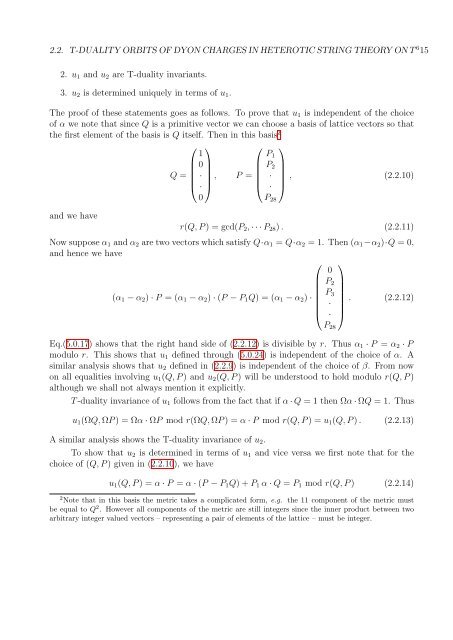PHYS08200604018 Shamik Banerjee - Homi Bhabha National ...
PHYS08200604018 Shamik Banerjee - Homi Bhabha National ...
PHYS08200604018 Shamik Banerjee - Homi Bhabha National ...
Create successful ePaper yourself
Turn your PDF publications into a flip-book with our unique Google optimized e-Paper software.
2.2. T-DUALITY ORBITS OF DYON CHARGES IN HETEROTIC STRING THEORY ON T 6 15<br />
2. u 1 and u 2 are T-duality invariants.<br />
3. u 2 is determined uniquely in terms of u 1 .<br />
The proof of these statements goes as follows. To prove that u 1 is independent of the choice<br />
of α we note that since Q is a primitive vector we can choose a basis of lattice vectors so that<br />
the first element of the basis is Q itself. Then in this basis 2<br />
⎛ ⎞<br />
and we have<br />
1<br />
0<br />
Q =<br />
⎜ ·<br />
⎟<br />
⎝ · ⎠ ,<br />
0<br />
⎛ ⎞<br />
P 1<br />
P = P 2<br />
⎜ ·<br />
⎟<br />
⎝ · ⎠ , (2.2.10)<br />
P 28<br />
r(Q, P ) = gcd(P 2 , · · · P 28 ) . (2.2.11)<br />
Now suppose α 1 and α 2 are two vectors which satisfy Q·α 1 = Q·α 2 = 1. Then (α 1 −α 2 )·Q = 0,<br />
and hence we have<br />
⎛ ⎞<br />
0<br />
P 2<br />
(α 1 − α 2 ) · P = (α 1 − α 2 ) · (P − P 1 Q) = (α 1 − α 2 ) ·<br />
P 3<br />
⎜ ·<br />
. (2.2.12)<br />
⎟<br />
⎝ · ⎠<br />
P 28<br />
Eq.(5.0.17) shows that the right hand side of (2.2.12) is divisible by r. Thus α 1 · P = α 2 · P<br />
modulo r. This shows that u 1 defined through (5.0.24) is independent of the choice of α. A<br />
similar analysis shows that u 2 defined in (2.2.9) is independent of the choice of β. From now<br />
on all equalities involving u 1 (Q, P ) and u 2 (Q, P ) will be understood to hold modulo r(Q, P )<br />
although we shall not always mention it explicitly.<br />
T -duality invariance of u 1 follows from the fact that if α · Q = 1 then Ωα · ΩQ = 1. Thus<br />
u 1 (ΩQ, ΩP ) = Ωα · ΩP mod r(ΩQ, ΩP ) = α · P mod r(Q, P ) = u 1 (Q, P ) . (2.2.13)<br />
A similar analysis shows the T-duality invariance of u 2 .<br />
To show that u 2 is determined in terms of u 1 and vice versa we first note that for the<br />
choice of (Q, P ) given in (2.2.10), we have<br />
u 1 (Q, P ) = α · P = α · (P − P 1 Q) + P 1 α · Q = P 1 mod r(Q, P ) (2.2.14)<br />
2 Note that in this basis the metric takes a complicated form, e.g. the 11 component of the metric must<br />
be equal to Q 2 . However all components of the metric are still integers since the inner product between two<br />
arbitrary integer valued vectors – representing a pair of elements of the lattice – must be integer.

















